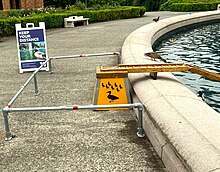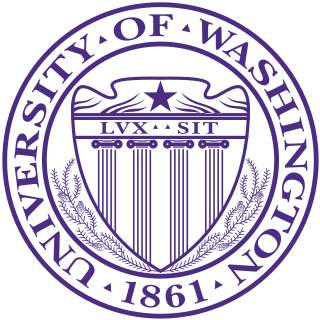
The University of Washington is a public research university in Seattle, Washington, United States. Founded in 1861, the University of Washington is one of the oldest universities on the West Coast of the United States.

The Alaska–Yukon–Pacific Exposition, acronym AYP or AYPE, was a world's fair held in Seattle in 1909 publicizing the development of the Pacific Northwest. It was originally planned for 1907 to mark the 10th anniversary of the Klondike Gold Rush, but the organizers learned of the Jamestown Exposition being held that same year and rescheduled.

Portage Bay is a body of water, often thought of as the eastern arm of Lake Union, that forms a part of the Lake Washington Ship Canal in Seattle, Washington.

The Burke Museum of Natural History and Culture is a natural history museum on the campus of the University of Washington, in Seattle, Washington, United States. It is administered by the UW College of Arts and Sciences. Established in 1899 as the Washington State Museum, the museum traces its origins to a high school naturalist club formed in 1879. The museum is the oldest in Washington state and boasts a collection of more than 16 million artifacts, including the world's largest collection of spread bird wings. The Burke Museum is the official state museum of Washington.

State Route 513 (SR 513) is a 3.35-mile-long (5.39 km) state highway in the U.S. state of Washington, located entirely within the city of Seattle in King County. The highway travels north as Montlake Boulevard from an interchange with SR 520 and over the Montlake Bridge to the University of Washington campus in the University District. SR 513 continues past University Village before it turns northeast onto Sand Point Way and ends at the entrance to Magnuson Park in the Sand Point neighborhood.
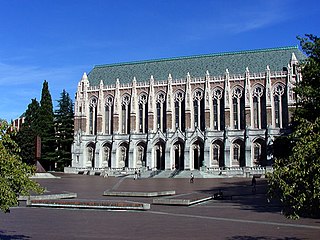
Red Square, officially Central Plaza, is a large open square on the Seattle campus of the University of Washington that serves as a hub for two of the university's major axes, connecting the campus's northern Liberal Arts Quadrangle with the science and engineering buildings found on the lower campus. The plaza is paved with red brick, and becomes notoriously slippery during rain.

Meyer Robert Guggenheim was an American diplomat and a member of the prominent Guggenheim family.

Ravenna Park and Cowen Park comprise a single contiguous recreation and green space in the Ravenna neighborhood of Seattle, Washington in the United States. These public parks encompass the ravine with a maximum depth of 115 feet (35 m) through which Ravenna Creek flows.

John Galen Howard was an American architect and educator who began his career in New York before moving to California. He was the principal architect at several firms in both states and employed Julia Morgan early in her architectural career.

John Charles Olmsted was an American landscape architect. The nephew and adopted son of Frederick Law Olmsted, he worked with his father and his younger brother, Frederick Law Olmsted Jr., in their father's firm. After their father retired, the brothers took over leadership and founded Olmsted Brothers as a landscape design firm. The firm became well known for designing many urban parks, college campuses, and other public places. John Olmsted's body of work from over 40 years as a landscape architect has left its mark on the American urban landscape.

Meany Hall has been the name of two buildings on the University of Washington campus in Seattle. The current Meany Hall is considered one of the region's premier performance facilities, highly acclaimed by artists and audience members alike for its outstanding acoustics and intimate ambiance. Individual performance venues include the 1,206-seat proscenium Katharyn Alvord Gerlich Theater, and the 238-seat Meany Studio Theatre.
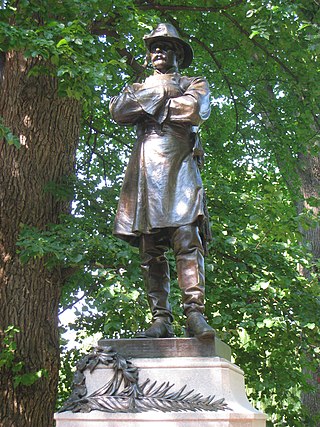
Richard Edwin Brooks (1865–1919) was born in Braintree, Massachusetts, studied in Paris under the sculptor Jean-Paul Aubé (1837–1916). His early work Chant de la Vague was idealistic; later works were more conventional statues.

The Rainier Club is a private club in Seattle, Washington; it has been referred to as "Seattle's preeminent private club." Its clubhouse building, completed in 1904, is listed on the National Register of Historic Places. It was founded in 1888 in what was then the Washington Territory. As of 2008, the club has 1,300 members.
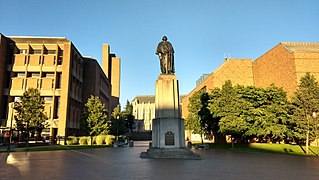
The Campus of the University of Washington is located in the University District of Seattle. Campus buildings are categorized by the major street or vicinity on which they are located on campus. In 2011, Slate magazine and Travel+Leisure described the Seattle campus as one of the most beautiful university campuses in the United States.

George Washington, also known as the President George Washington Monument, is a bronze sculpture of George Washington by Lorado Taft, installed at the University of Washington campus in Seattle's University District, in the U.S. state of Washington.
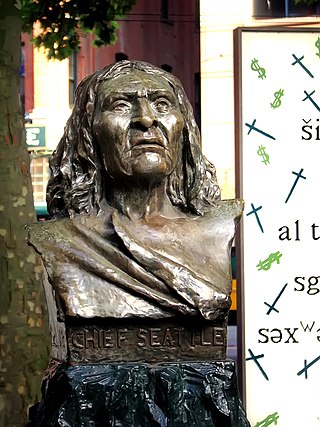
Chief of the Suquamish – Chief Seattle, also known as Bust of Chief Seattle and Chief Seattle Fountain, is a bust depicting Chief Seattle by artist James A. Wehn. It was commissioned by the Seattle Park Board to accommodate the Alaska-Yukon-Pacific Exposition, and initially sat on a fountain for men, dogs and horses.

The Liberal Arts Quadrangle, more popularly known as the Quad, is the main quadrangle at the University of Washington in Seattle, Washington. It is often considered the school's trademark attraction. Raitt Hall and Savery Hall frame the northwestern boundary while Gowen, Smith, and Miller Halls frame the southeast. At the top of the quad sits the latest buildings on the quad, the Art and Music Buildings. The quad is lined with thirty Yoshino cherry trees, which blossom between mid-March and early April.

Frank Hamilton Nowell was an American photographer who worked in Alaska and Seattle. His photos from Alaska include mining operations, panoramic vistas, ships, important buildings, and indigenous people. He was the official photographer for the Alaska Yukon Pacific Exposition of 1909 in Seattle.
A freshman, first year, or frosh, is a person in the first year at an educational institution, usually a secondary or post-secondary school.
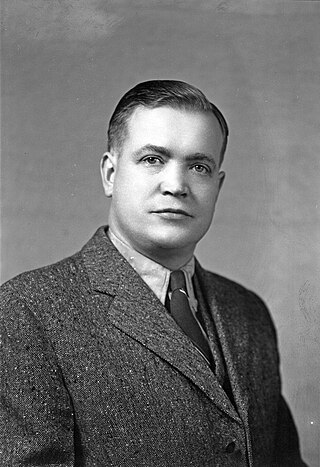
Joseph Drumheller was an American chemical engineer and politician in the state of Washington. He was a Democratic member of the Washington State Senate between 1935 and 1942, representing the 7th district. He was also a member of the Board of Regents for the University of Washington between 1945 and 1950 and then from 1956 to 1968.


